There are a lot of interesting Nigeria water statistics.
In this statistic roundup post, you'll discover all of the latest Nigerian water stats.
Let's get to them right away.
Nigeria water statistics (Key Stats & Facts)
- Nigeria has 215 cubic kilometres of available surface water per year and also plenty stored in the ground.
- 70% of the people in Nigeria have access to basic water supply but little access to clean drinking water.
- In rural areas in Nigeria, 39% of households lack access to at least basic water supply.
- The Average Nigerian uses 9 litres of water per day (compared to national acceptable minimum standards of 12 to 16 litres per day)
- Some of the most common sources of drinking water in Nigeria are tube wells, boreholes, and dug wells.
- Pipe-borne water accounts for 9.5% of domestic water supply to households (A significant drop from 61.6% in 1995)
- Borehole accounts for 21.5% of tap water supply to households in Nigeria.
- 86% of Nigerian households declared not to treat water before drinking.
- 77.3% of Nigerians’ household drinking water is contaminated by bacteria ( especially E coli bacteria).
- Unsafe water sources are the cause of 7.34% of deaths in Nigeria.
- The most common waterborne diseases in Nigeria include cholera, typhoid, hepatitis and dracunculiasis.
- Most water supply pipes in Nigeria were laid in the 1970s. There has been little to no replacement or construction of new pipelines since then.
- Nigeria has the 3rd largest market share for water filtration products within Sub-Saharan Africa, corresponding to 15% of the total (with South Africa coming in first at 43% and Ethiopia second at 18%).
- Nigeria has a low drought risk with an index score of 1.2 out of 5 (African countries with the highest risk include Somalia, Zimbabwe, Djibouti, Mauritania, and South Africa with the index of 5, 4.72, 4.68, 4.48 and 4.44 respectively)
- The top 5 bottled water brands in Nigeria are Eva Water ( by Coca Cola) Nestle Pure Life, Aquafina (from PepsiCo), Cascade, Redeemed Water and Bigi Table Water.
- 30% of the commercial bottled water and Sachet Drinking Water contains bacteria.
- 58% of Commercial Sachet Drinking Water are unfit to drink because they don't meet the recommended W.H.O standard.
- Commercial Sachet Drinking Water cost as much as 20 times more than tap water from Nigerian Water Board.
- About 29% (26.5 million) of Nigerian children do not have enough water to meet their daily needs.
- 73% of diarrhea and enteric disease cases in Nigeria are connected to low access to safe and clean water, sanitation and hygiene (WASH). These diseases tend to disproportionally affect the poor and disadvantaged, especially children.
- The poor access to improved water and sanitation in Nigeria is still the major contributor to high mortality rates among children less than 5 years old.
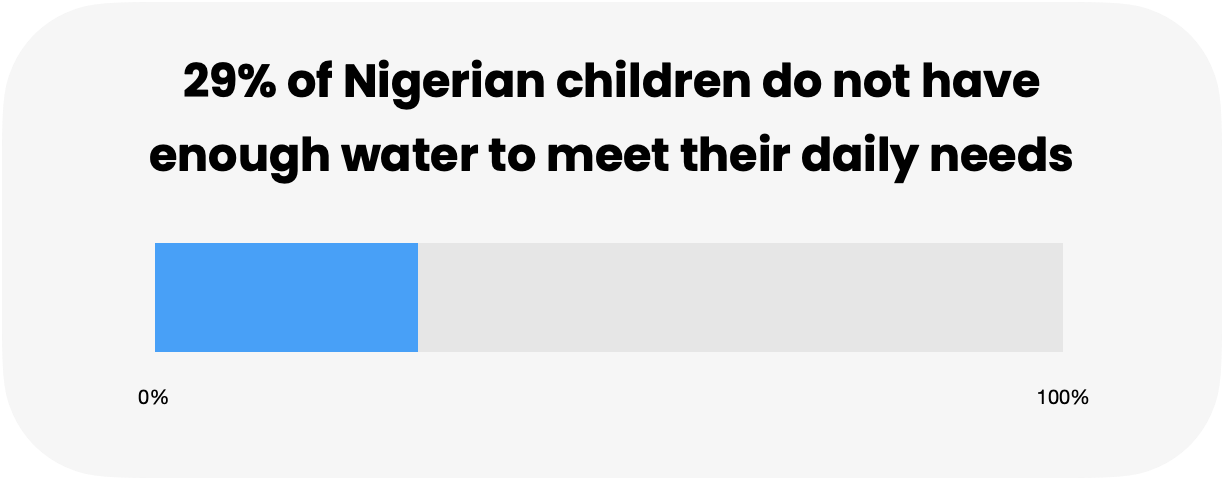
Does Nigeria Have good water?
Nigeria is blessed with plenty of good water sources. It has about 215 cubic kilometres of available surface water per year and plenty of water stored in the ground. However, unfortunately, Nigeria has little access to clean drinking water from its plentiful sources.
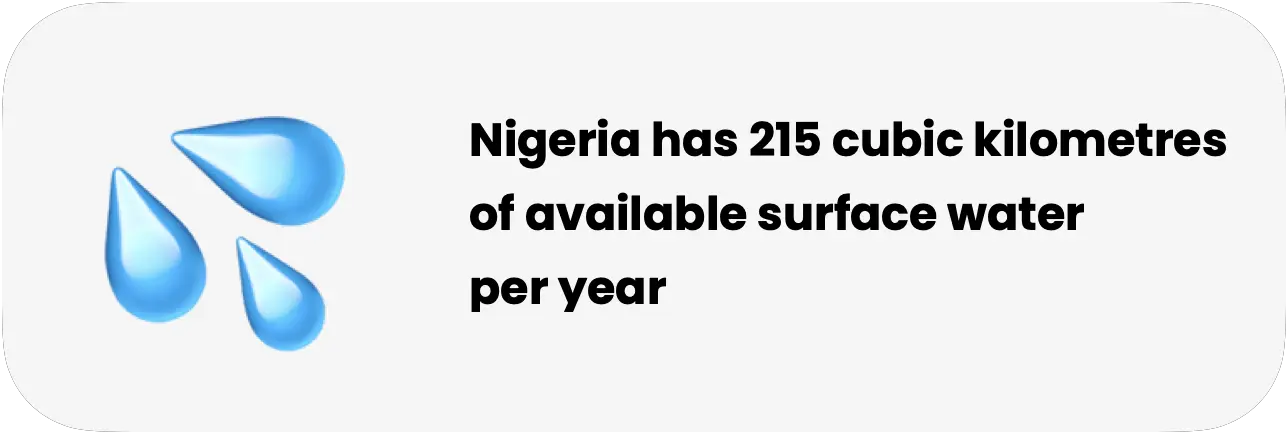
Does Nigeria Have access to Basic water Supply
70% of the people in Nigeria have access to basic water supply, according to a new analysis released by UNICEF. However, this basic water supply is not evenly distributed.
82% of people in the cities have basic water supply, while only 54% of people in rural areas do. Not only that, the wealthy segment in Nigeria typically has greater access to basic water supply than the poor segment. Nearly 80% of well-off Nigerians have at least a basic water supply, whereas only 48% in the lower-income group have such access, according to World Health Organization (WHO) and the United Nations Children’s Fund (UNICEF).
How much water does the average Nigerian use?
The Average Nigerian uses 9 litres of water per day (compared to national acceptable minimum standards of 12 to 16 litres per day), according to a report released by Nigeria’s Federal Ministry of Water Resources and UNICEF.
How many people in Nigeria do not have clean water?
A survey conducted by Nigeria’s Bureau of Statistics and UNICEF showed that about 60 million Nigerians do not have access to clean drinking water, which translate to about 33% of the population.
What percentage of Nigeria has Access to clean water?
According to WHO (World Health Organisation), only about 19% of the people in Nigeria have access to safe and clean drinking water, even though 70% of the Nigerian population have access to basic water supply.
Is it safe to drink tap water in Nigeria?
It is generally not safe to drink tap water in Nigeria because it mostly contains bacteria, pollutants and chemical contaminants, as most of Nigeria’s drinking water is unpurified ground water.
For example, a recently published data by UNICEF and WHO revealed that 77.3% of Nigeria's households drinking water is contaminated by bacteria at source. Furthermore, there is also an increase in contamination between source and household (Which suggests that some level of contamination occurs during transportation and storage)
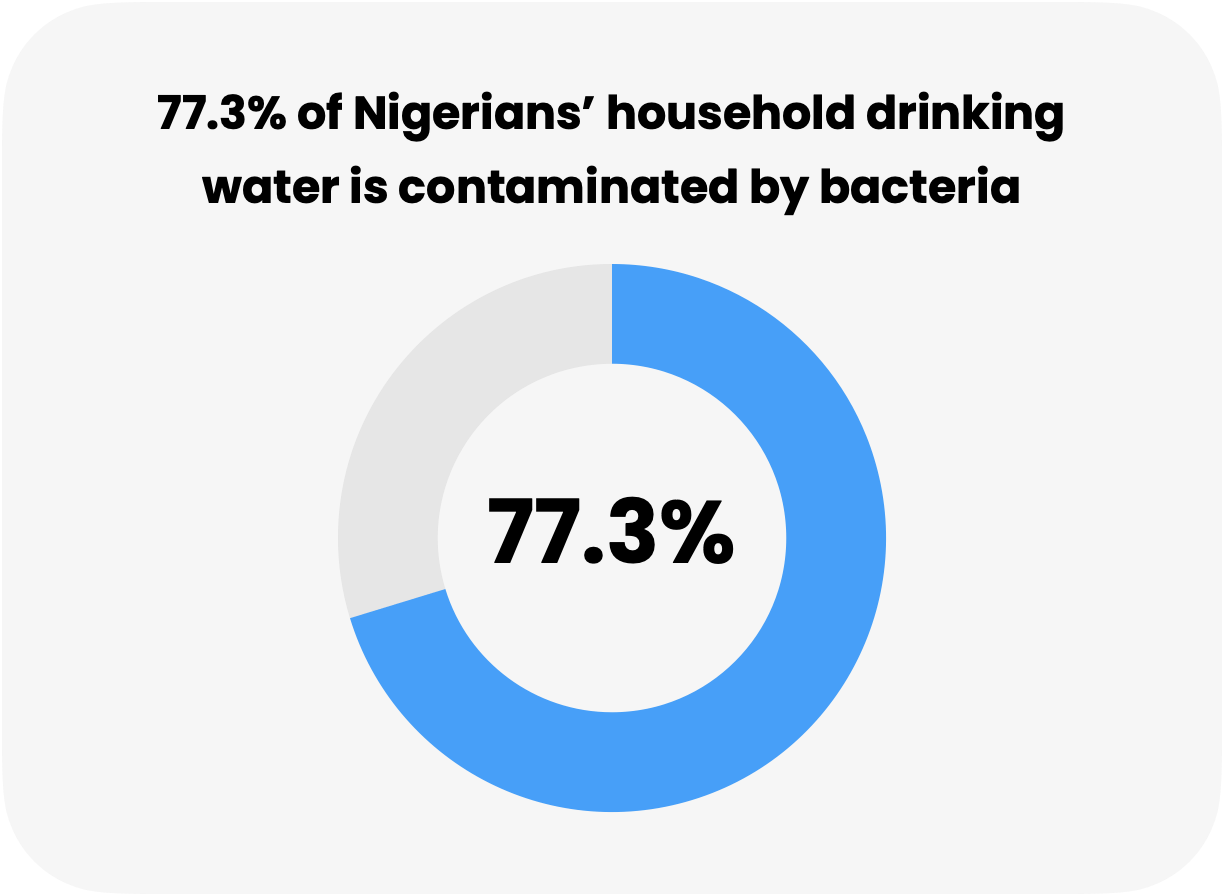
Also, a 2017 study concluded that 90.8% of household drinking water in Nigeria is contaminated by E coli bacteria.
Abuja is outfitted with the best water treatment plant in Nigeria and still not safe to drink because of unreliable power supply and lack of capacity for a consistent clean water supply.
Why does Nigeria have no clean water?
Nigeria does not have clean water due to many challenges including poor maintenance culture, shortage of trained human capital, inadequate infrastructure, poor investment and regulatory environment.
Also, industrial pollution activities contributes massively to making the local
river water sources unsuitable for human or agricultural purposes.
The water that is treated by different Municipal bodies meets drinking water standards before it enters the distribution system. However, water is often contaminated in the distribution network. This largely due to the fact that most water supply pipes in Nigeria were laid in the 1970’s. There has been little to no replacement or construction of new pipelines since then.
For example, the Lagos Water Corporation states that 12.5 million people in Lagos are supplied with safe drinking water, which comes from a plant that adheres strictly to the quality regulations. However, water often becomes contaminated on its way to homes.
How do Nigerians get their tap water?
According to National statistics of bureau, pipe-borne water accounts for 9.5% and borehole accounts 21.5% of tap water supply to households in Nigeria as of 2010.
Pipe-borne water used to be the major source of water supply in Nigeria up until 2006.
Here's a table from National statistics of bureau showing distribution of water supply to households in Nigeria from 1995 to 2010
Type of Water | 1995/96 | 1997/98 | 1999/2000 | 2006 | 2007 | 2008 | 2010 |
|---|---|---|---|---|---|---|---|
Pipe-borne Water | 61.60 | 56.57 | 54.10 | 11.37 | 10.4 | 8.8 | 9.5 |
Borehole | 1.00 | 1.07 | 0.40 | 13.61 | 26.8 | 28.4 | 21.5 |
Well | 8.50 | 13.41 | 15.80 | 35.77 | 33.3 | 31.5 | 35.0 |
Streams/Pond | 28 90 | 28 97 | 29.70 | 21.45 | 24.4 | 27.1 | 13.9 |
Tanker/Truck/Van | - | - | - | 5.88 | 4.1 | 3.2 | 2.0 |
Rain | - | - | - | 8.65 | 0.6 | 0.5 | 27.1 |
Others | - | - | - | 3.26 | 0.3 | - | 1.0 |
Total | 100.00 | 100.00 | 100.00 | 100.00 | 100.00 | 100.00 | 100.00 |
Is bottled water and sachet water safe to drink in Nigeria?
It is safe to drink some bottled water, especially the ones from well-known brands in Nigeria. However, 70% of commercial sachet waters (generally called Pure water) are not safe to drink.
For example, one study conducted in 2017 revealed that 200+ bottled and sachet water samples collected for testing showed that 30% of them had bacteria. In fact, there were areas where 70% of water samples were contaminated with contaminants that exceed WHO recommended limits. (One reason for this is poor storage and temperature control).
Sachet water (Pure water) which happens to be the major source of drinking water for low and medium-class Nigerians, generally, has worst quality than bottled water.
A study was done on fifty sachet water samples purchased from 20 random street vendors of Lagos. 58% were not safe for human consumption. Of that, 42% had intestinal parasites of cysts and eggs.
What's more is that commercial sachet drinking water costs as much as 20 times more the tap water from the Nigerian Water Board, according to a survey of street vendors in Lagos, Kaduna and Katsina state, Nigeria.
Finally, it is worth knowing that the top 5 bottle water brands in Nigeria are Eva Water ( by Coca Cola) Nestle Pure Life, Aquafina (from PepsiCo), Cascade, Redeemed Water and Bigi Table Water.
What is the coverage of portable water supply in Nigeria?
According to a study in Oyo state, Nigeria, the coverage of portable water supply is 27.3%. However, 62.74% of the population has access to a potable water supply. This means that more than 35% of the population is sourcing potable water from independent sources.
What are the Common Drinking water sources in Nigeria?
A survey released by NBS (Nigeria) showed that some of the most common sources of clean drinking water are boreholes, dug wells, and tube wells. These sources vary with the seasons and in some cases are used interchangeably.
Data published by Doris Dokua Sasu shows share of sources of drinking water in Nigeria as of 2018, by season. Here is a graphical representation:
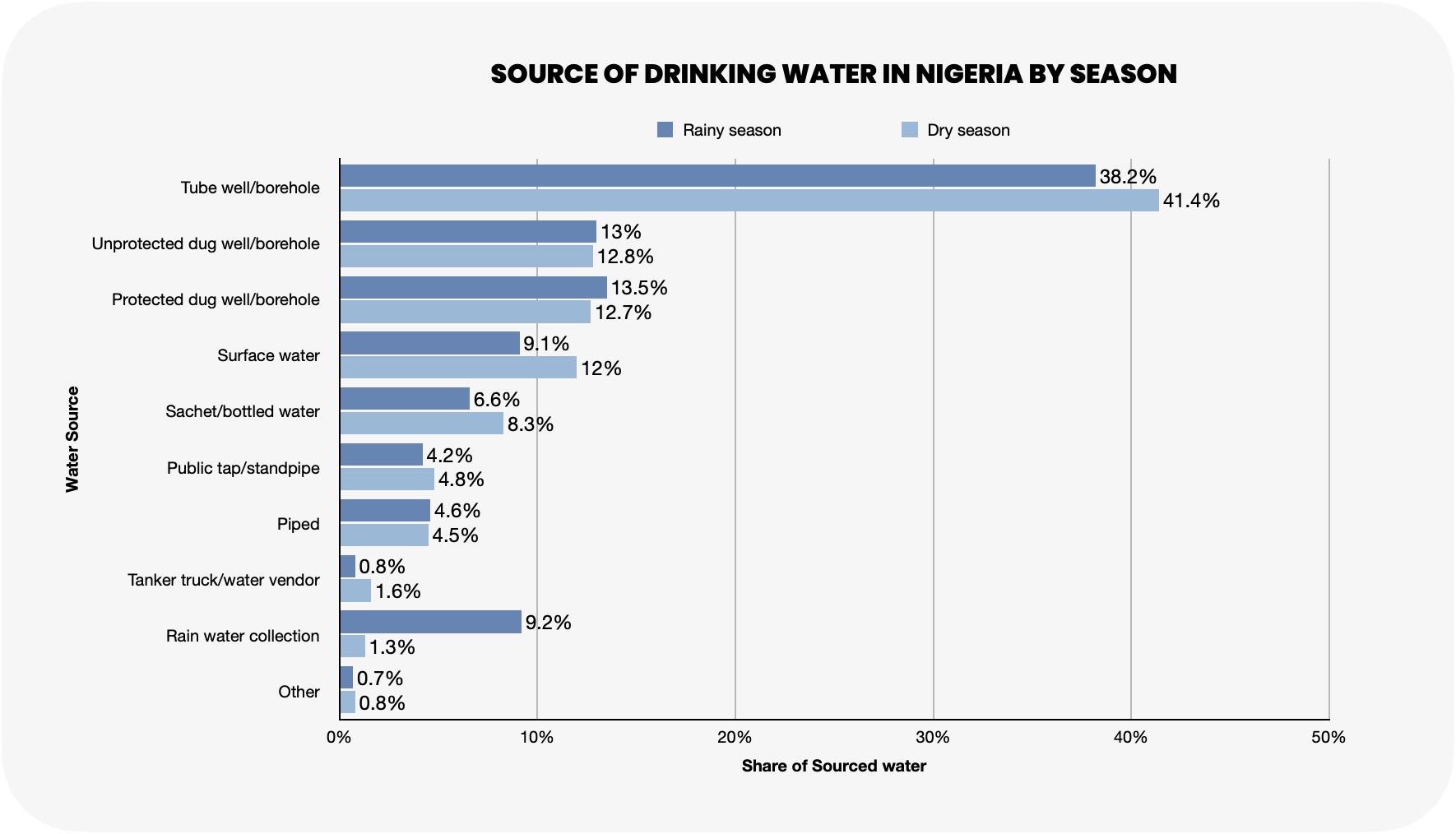
It is interesting to note that over the years, boreholes are getting more popular. A survey showed that there were about 65,000 boreholes or other groundwater points in Nigeria as of 2013.
Distribution of households who treat water for safe drinking in Nigeria as of 2020
A 2020 survey conducted on people between the ages of 15 and 35 revealed that 86% of Nigerian households declared not to pre-treat their water before drinking.
Share of deaths due to unsafe water sources in Nigeria
A global survey published by IHME (Global Burden of Disease) revealed that unsafe water sources are the cause of 7.34% of deaths in Nigeria as of 2017. The survey also revealed that worldwide, unsafe water sources accounts for 6% of deaths in low-income countries. However the number of deaths due to unsafe water sources has generally decreased over time.
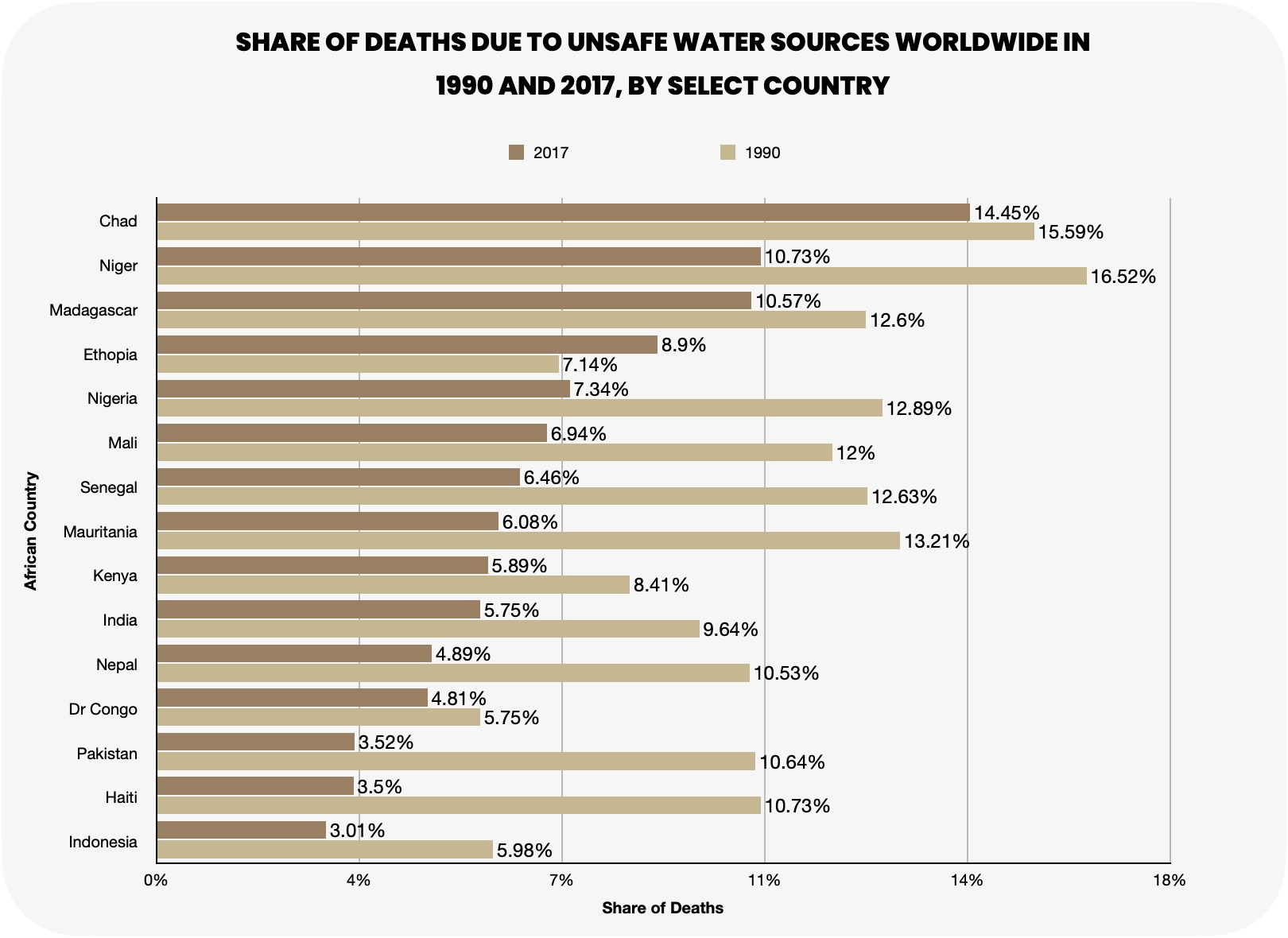
population share having access to at least basic drinking water in Africa
According to this statistic from Statista, , this is a list of countries in Africa according to the estimated population share having access to at least basic drinking water in 2020
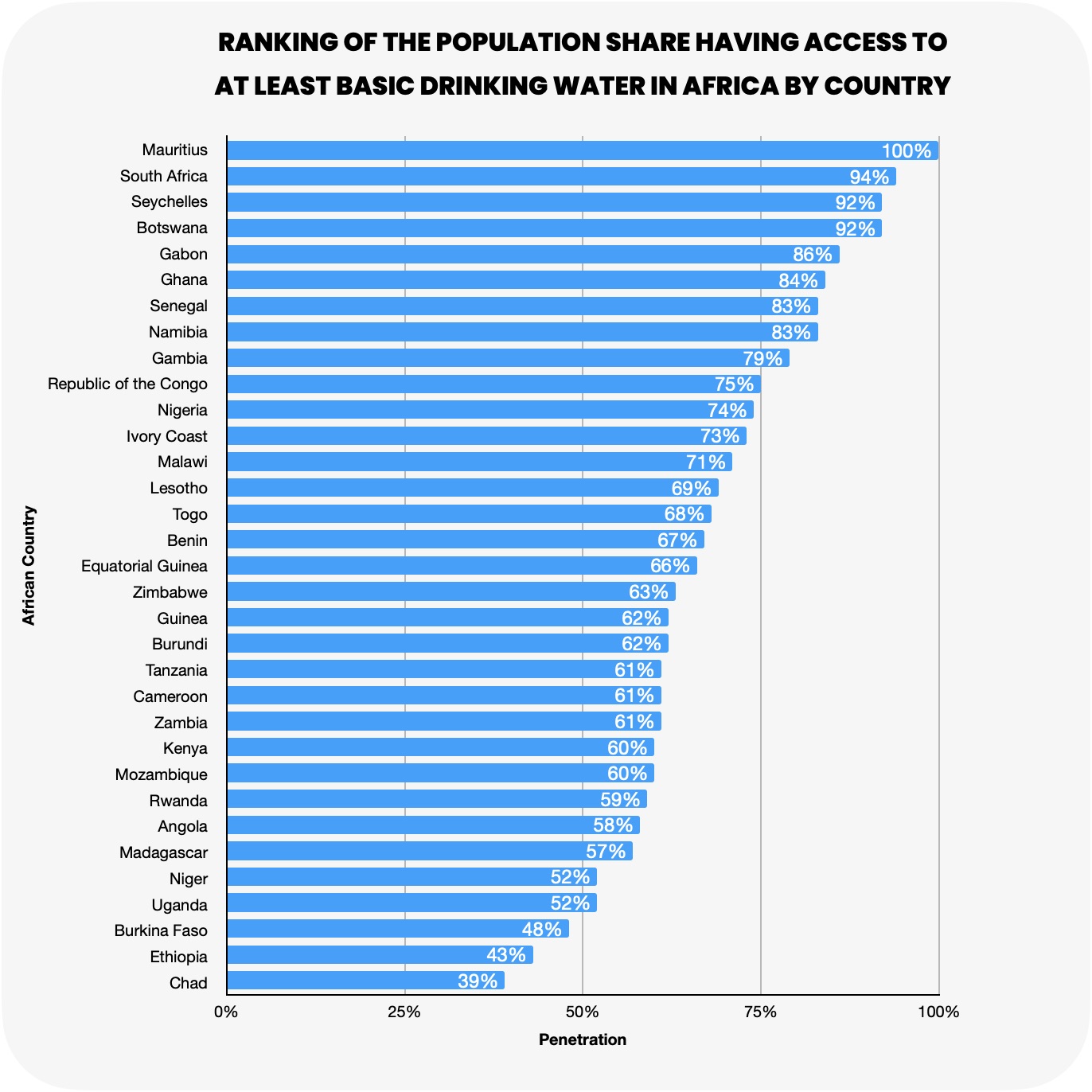
What's the probability of Drought in nigeria
According to 2020 Survey by IEP, Nigeria has a low drought risk with index score of 1.2 out of 5 (African countries with the highest risk includes Somalia, Zimbabwe, Djibouti, Mauritania, and South Africa with index of 5, 4.72, 4.68, 4.48 and 4.44 respectively)
What are the main River sources in Nigeria?
The main river sources are river Niger and river Benue amongst many other surface water sources. However, domestic, agricultural and industrial water supplies are mostly gotten from groundwater sources.
Sources
https://www.worldbank.org/en/news/feature/2021/05/26/nigeria-ensuring-water-sanitation-and-hygiene-for-all
https://www.unicef.org/nigeria/water-sanitation-and-hygiene
https://www.unicef.org/nigeria/press-releases/nearly-one-third-nigerian-children-do-not-have-enough-water-meet-their-daily-needs
https://www.statista.com/statistics/1192742/market-share-of-water-technology-products-in-sub-saharan-africa-by-country/
http://apps.who.int/iris/bitstream/10665/258617/1/9789241512893-eng.pdf?ua=1
https://www.unicef.org/nigeria/stories/new-survey-reveals-progress-and-gaps-nigerians-access-water-sanitation-and-hygiene-services
https://washdata.org/report/who-unicef-radwq-nigeria-report
https://dailytrust.com/a-peep-into-source-of-abujas-drinking-water
https://www.worldbank.org/en/news/feature/2021/05/26/nigeria-ensuring-water-sanitation-and-hygiene-for-all
https://core.ac.uk/download/pdf/234664988.pdf
https://ejbio.imedpub.com/parasitological-evaluation-of-sachet-drinking-water-in-areas-oflagos-state-nigeria.php?aid=19001
https://irispublishers.com/gjnfs/fulltext/assessment-of-sachet-and-bottled-water-quality-in-ibadan-nigeria.ID.000519.php
https://www.sciencedirect.com/science/article/pii/S2667010021003139
https://nigerianstat.gov.ng/download/1241069
https://www.witpress.com/Secure/elibrary/papers/WRM13/WRM13002FU1.pdf
https://ourworldindata.org/water-access
https://ecologicalthreatregister.org/
http://www.bioline.org.br/pdf?md08035

Great piece highlighted